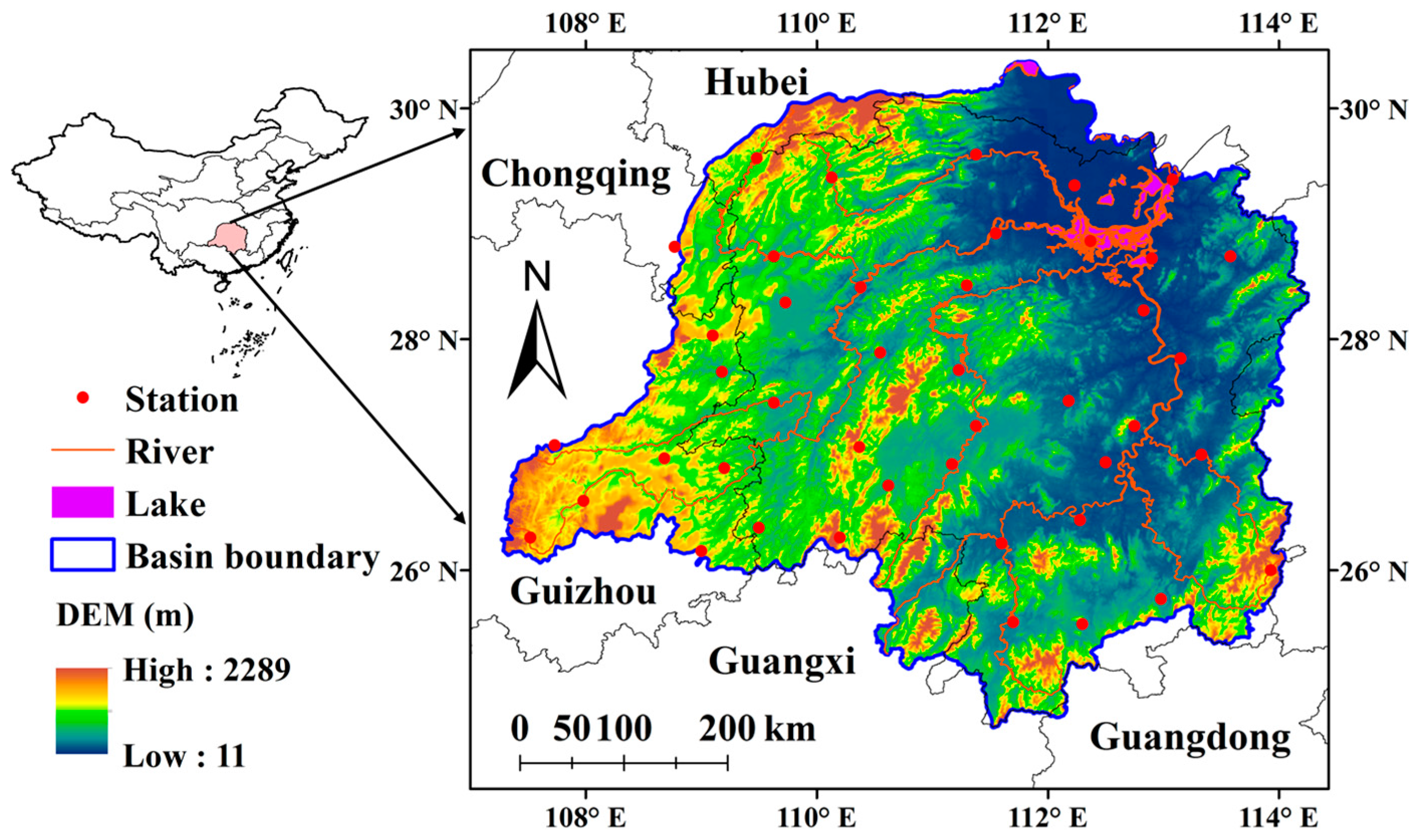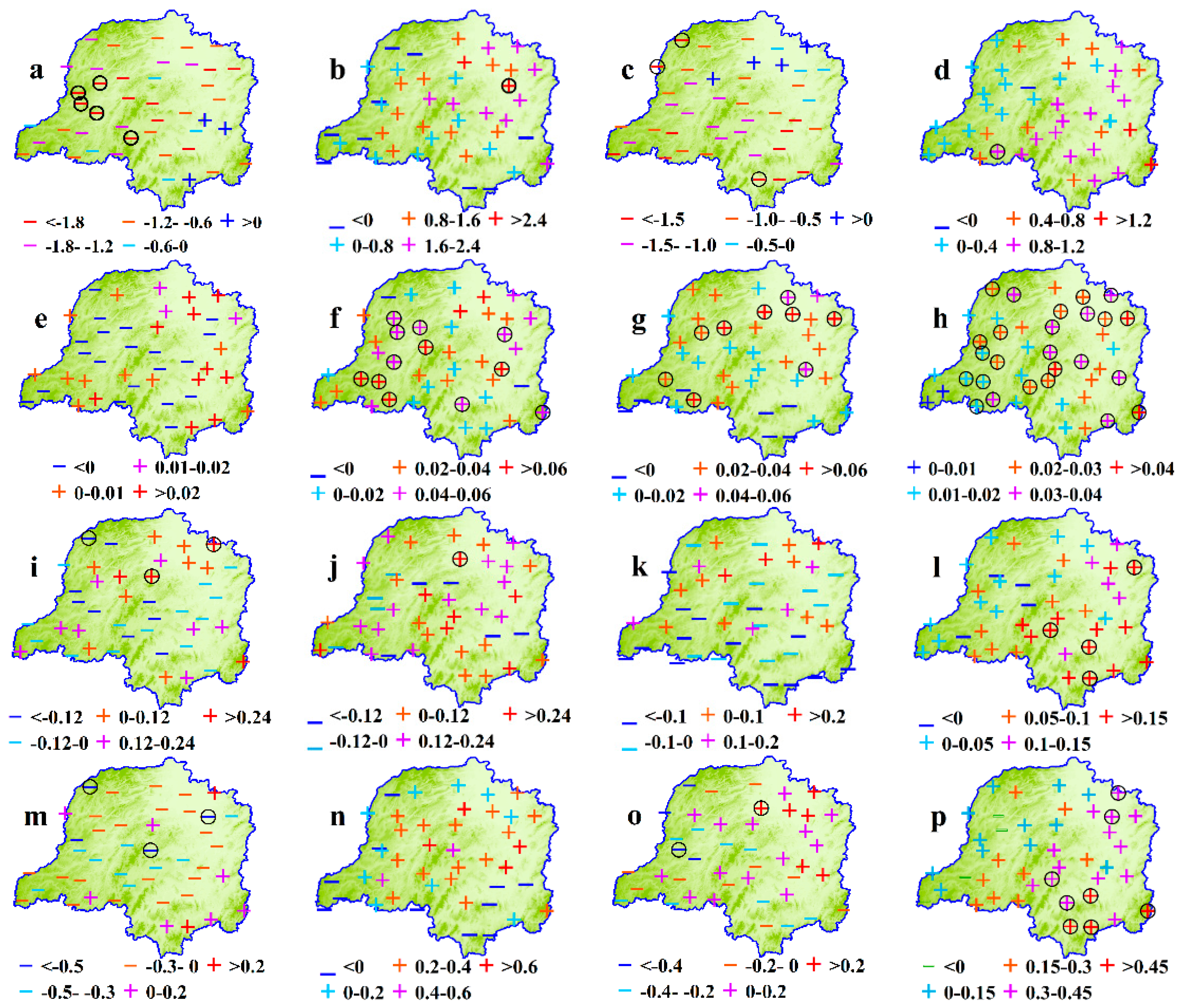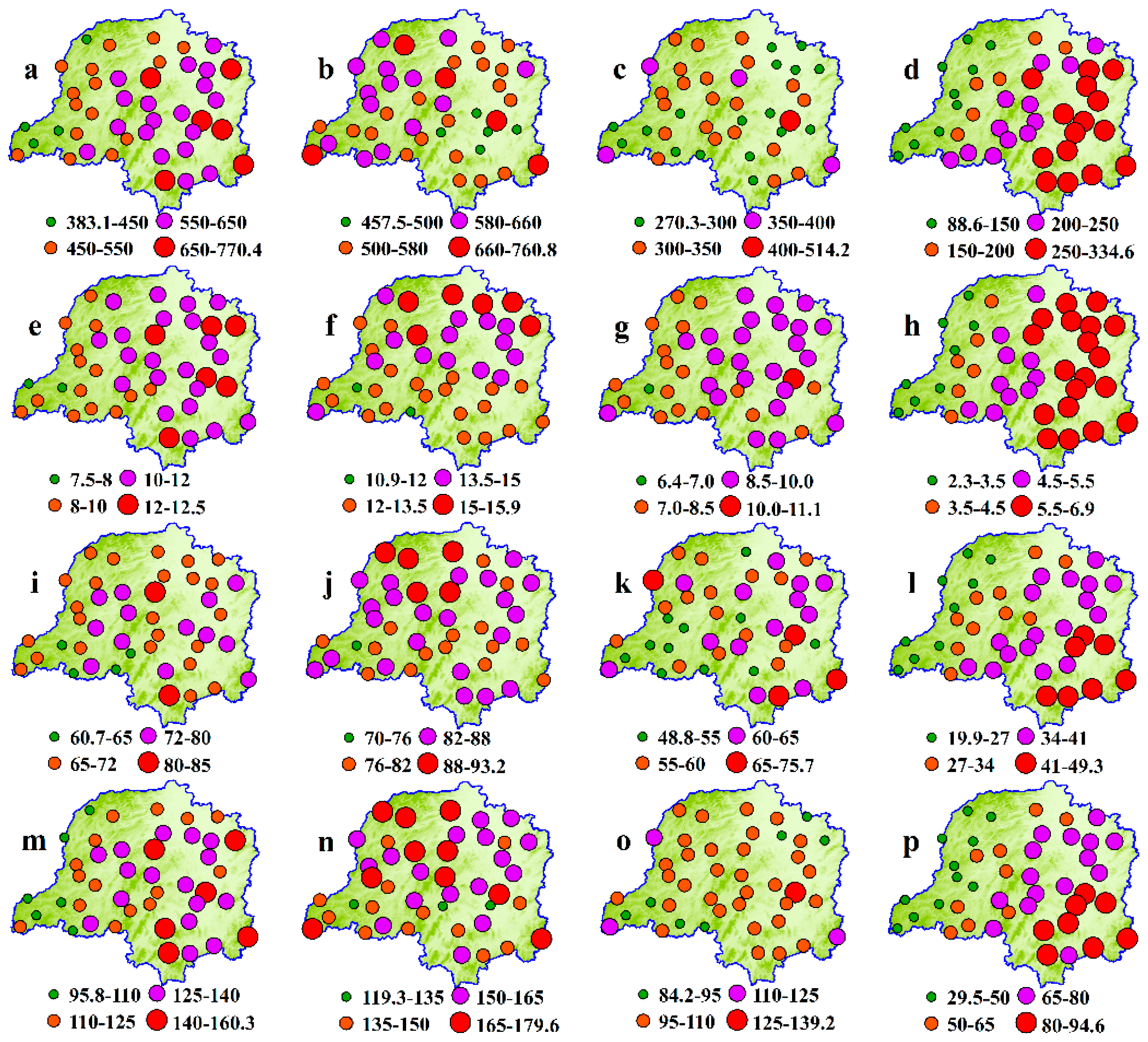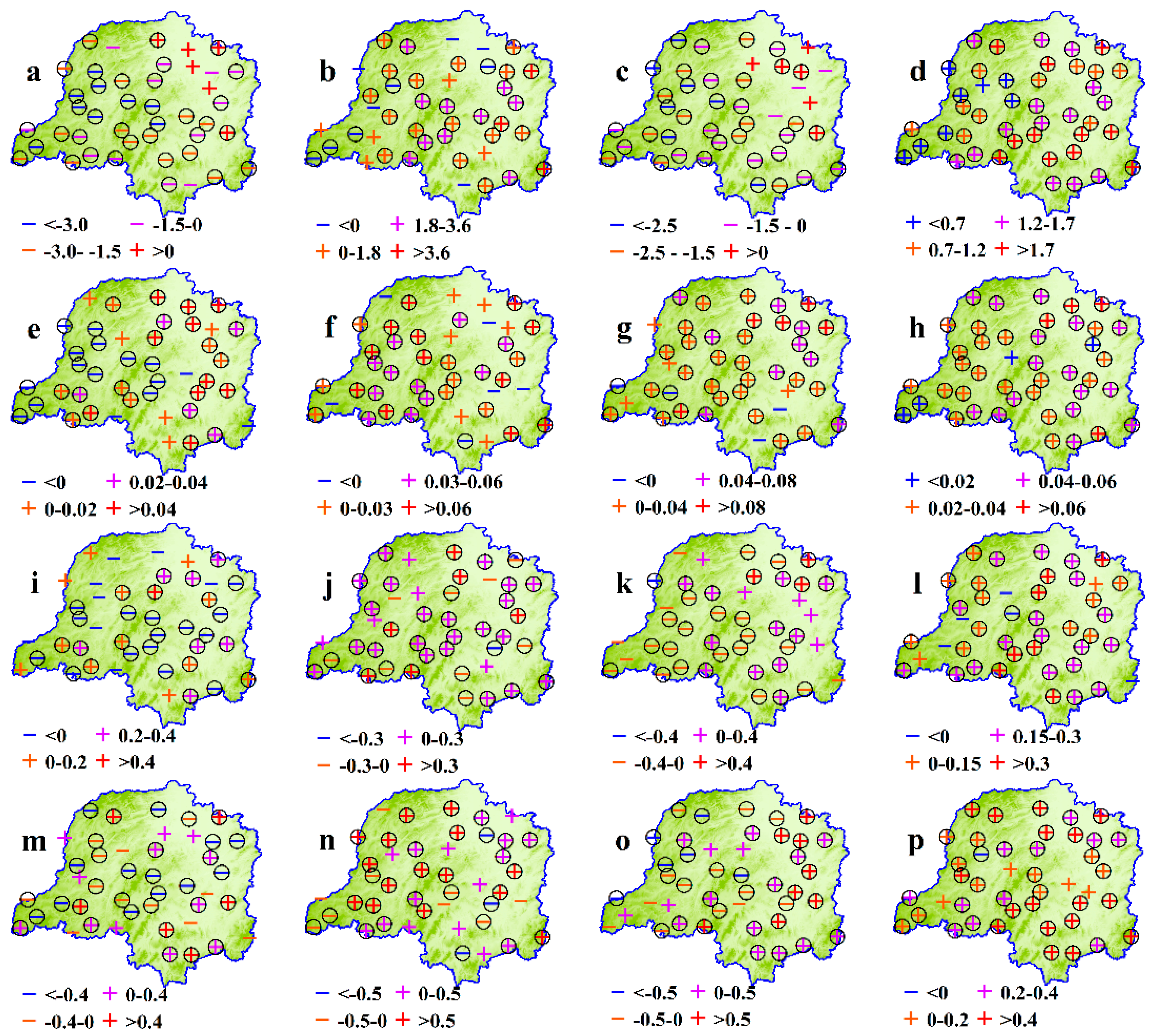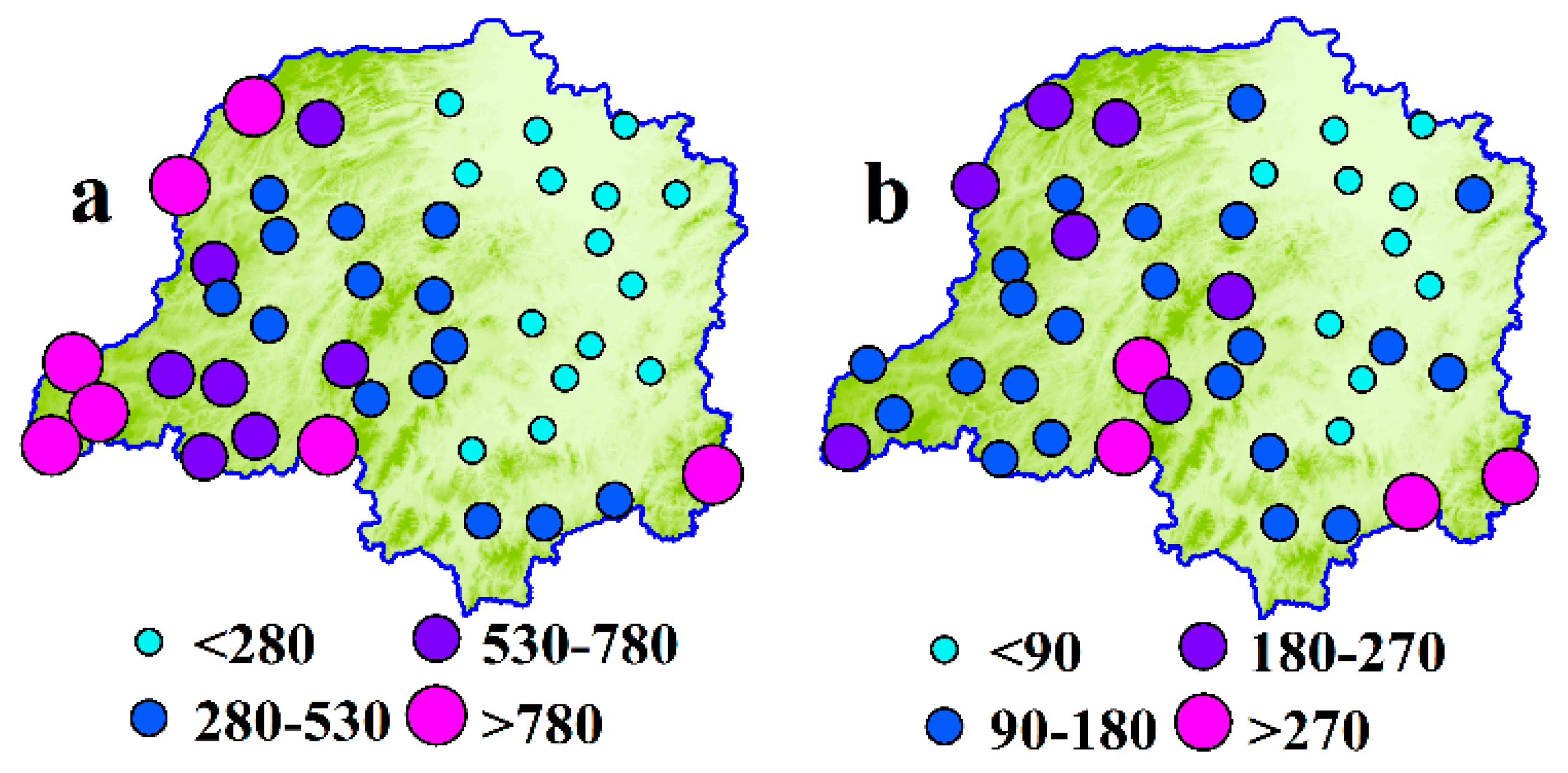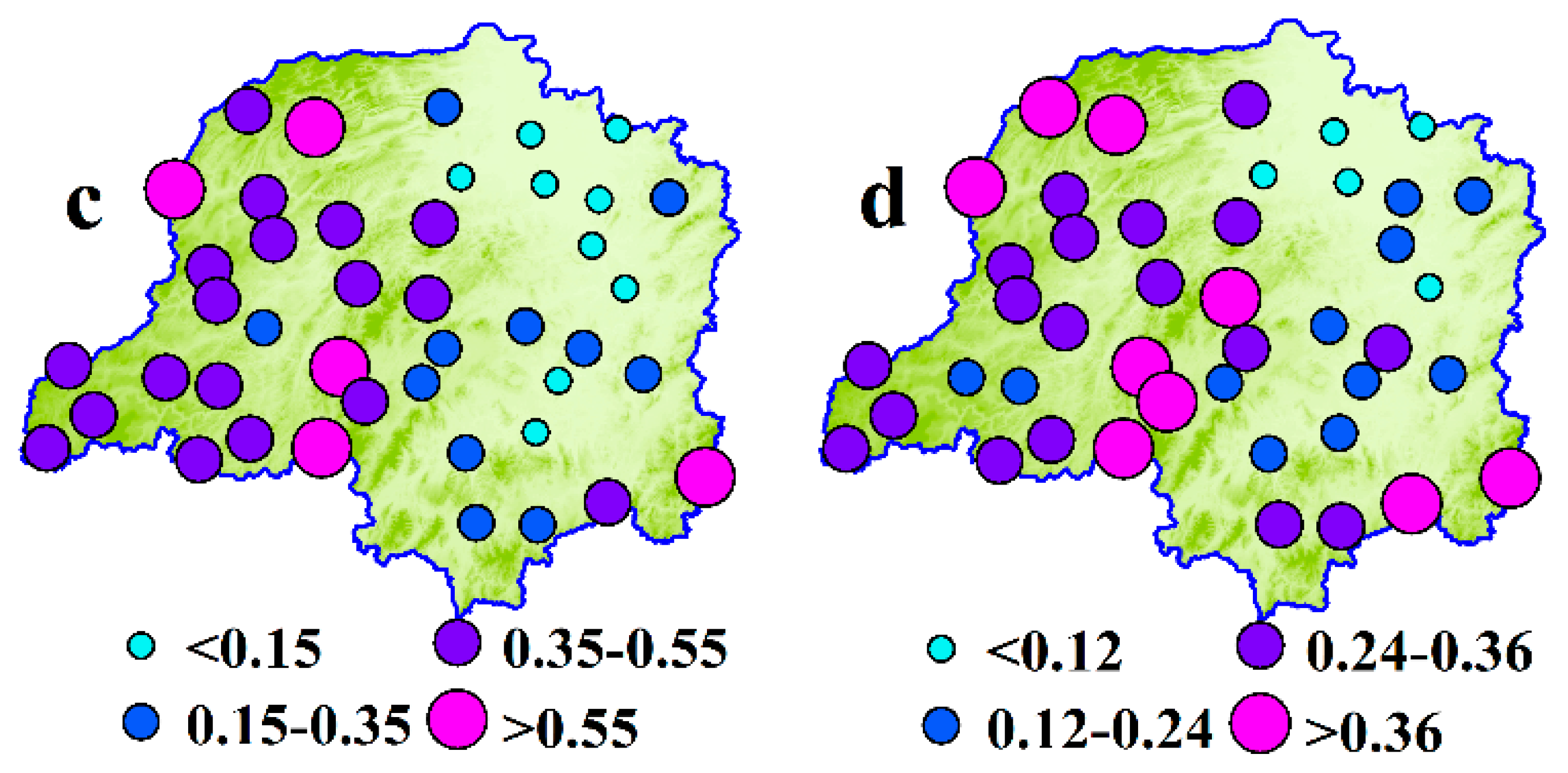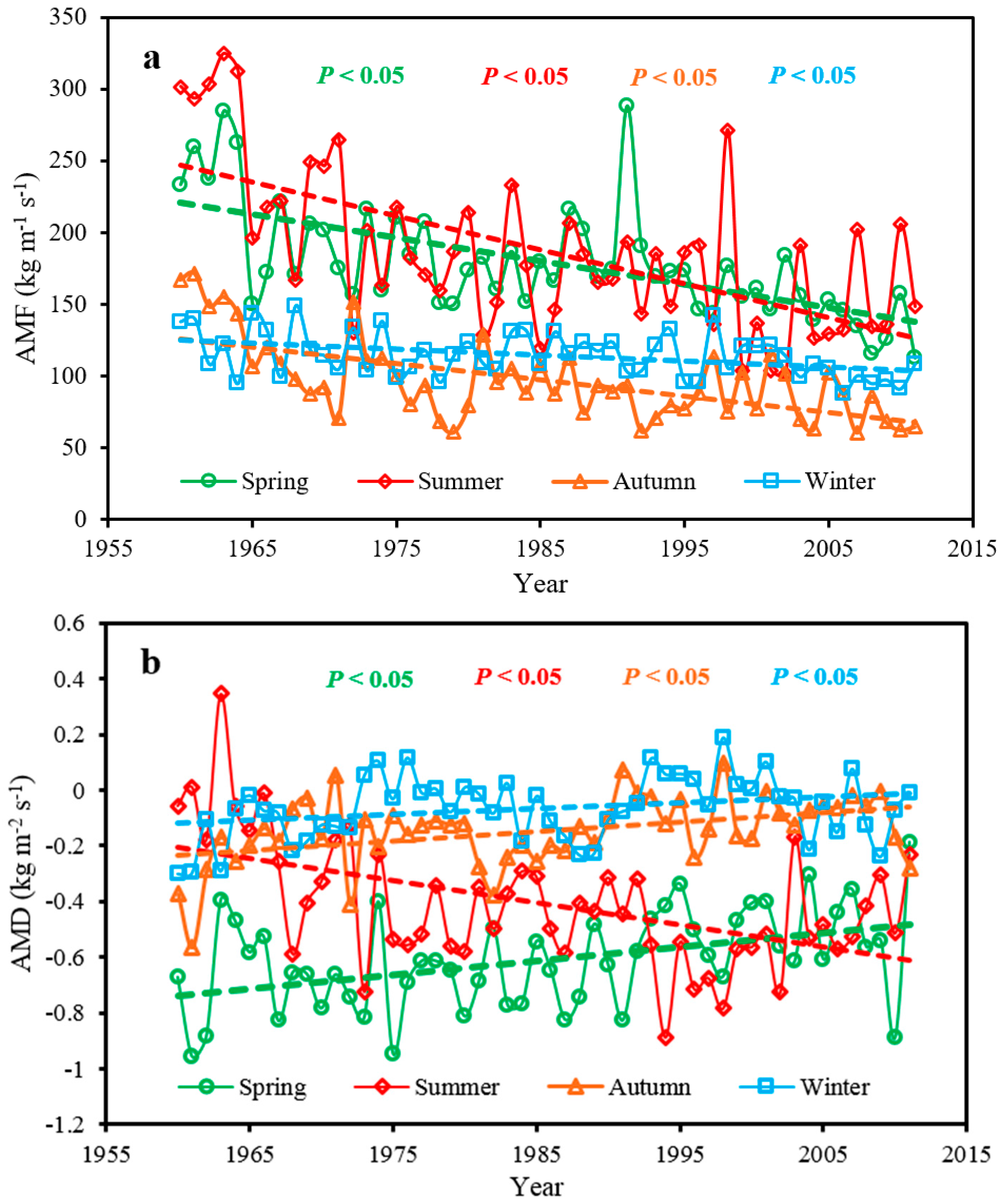1. Introduction
There is growing concern about extreme climate events due to the vulnerability of our society to the adverse impacts of such events [
1,
2,
3,
4]. Climate extremes, such as droughts, floods, cold weather, have brought huge damages on human society and the ecological environment around the world [
1,
5,
6,
7,
8]. However, in a gradually warming environment, the intensity and frequency of climate extremes have changed considerably in the past decades [
8].
The Dongting Lake Basin (DTLB), located in the middle reach of the Yangtze River, is an important grain and cash crop planting base in China. However, this region is sensitive to natural hazards [
9], and is also a well-known flood prone region [
10]. Records show that during the period of 1950–2009, floods (regardless of the severity) occurred almost every year in this basin [
11], and caused economical loss of about $0.3 billion per year in agriculture [
9,
12]. For example, the 1996 flood affected 38 cities, 1.1 × 10
6 hectare farmland, and about 7.2 million people’s livelihood and wealth, causing direct economic loss of $4.95 billion [
13]. While in 1998, a similar severe flooding hit this basin again and brought out huge damages to the water conservancy facilities, agriculture, and influenced deeply the people’s lives. However, climate change in this region is also relatively considerable [
14,
15]. Previous studies pointed out that the frequency of floods in DTLB increased significantly in the last half century [
16]. For example, in the periods of 1931–1990 and 1991–2000, there were 14 and 6 major floods, with the return periods of 4.3 and 1.7 years, respectively.
Indeed, there exist many factors that can influence the formation of flood, such as the water conservancy facilities, land cover and land usage, precipitation, etc. Nevertheless, paroxysmal large amount of water could be the prerequisite, which mainly attribute to heavy precipitation [
1]. Therefore, knowledge of the spatial-temporal characteristics of precipitation extremes is very important in disaster mitigation, water resources management, agriculture and policy making [
1]. Recently, many studies have focused on climate extremes at regional and global scale [
1,
3,
4,
8,
17,
18], and at varying time scales [
7,
19]. Similarly, climate extremes have also been intensively studied in China [
20,
21,
22,
23]. Overall, many of these studies focused on the changing patterns of several climate extreme indices [
20,
22], and some of them analyzed the probability distributions of the climate extremes [
1,
23,
24,
25] and investigated the potential underlying mechanisms or influencing factors, such as the ENSO events, SST, atmospheric circulation and topography [
15,
23,
26,
27]. A number of previous studies have attempted to characterize climate extremes in the DTLB. For example, Wang, Jiang, Wang and Yu [
14] reported that precipitation in DTLB exhibited apparent upward trends after 1990s (especially in summer), and the storm frequency in summer also increased obviously, while the storm intensity showed no significant changes. However, Xu, et al. [
28] concluded that during the period of 1960–2011, annual precipitation decreased gradually and had different changing directions in different seasons, but the trends were not significant; Song, et al. [
29] also pointed out that the precipitation extremes changed insignificantly in DTLB.
From these existing literatures, most of the researchers concluded that the precipitation had overall downward trends and precipitation extremes changed insignificantly in DTLB [
28,
29,
30,
31,
32]. The insignificant changing precipitation extremes could not reflect the facts that floods occurred more frequently in DTLB [
11,
13]. The explanation is that the previous studies mainly used some trend detection methods (e.g., MK test) to examine the trends of the precipitation [
28,
29,
31]. However, though trend detection can point out the overall changing patterns of a time series, it would also miss some information of individual events, e.g., the floods. In recent years, scholars tried to investigate the risks of precipitation extremes by employing probability distributions [
1,
23,
24,
25]. They found that although the initial precipitation indices had no significant trends, the risks of precipitation extremes always exhibited significant changes [
1,
23]. The risk of precipitation extreme shows the severity of event would reach at a given probability or the possibility that an extreme event would occur. Hence, the risk (or probability) characteristics of a precipitation index may be more effective in implying the evolution of extreme events. However, few studies have focused on this issue in DTLB. Therefore, this study aimed to (1) analyze the trends and probabilistic characteristics of precipitation extremes at seasonal scale; (2) investigate the potential influencing factors for the changing patterns of the precipitation extremes; and (3) evaluate the changing patterns of floods implied by the precipitation extremes.
4. Discussion
Humans and natural environment are vulnerable to the impacts of climate and weather extremes [
1]. The Dongting Lake Basin (DTLB) is a flood prone area in China, and floods have resulted in dramatic damages to the society and natural environment in this region [
43]. On the other hand, the Dongting Lake is the secondary largest freshwater lake in China, which plays important roles in regional economy development, regional environmental and ecological issues [
33]. Intensive precipitation events also have impacts on soil erosion and bring huge sediments or pollutants into the lake and result in high pressure of lake degradation and water pollution [
44,
45]. Comprehensive knowledge of the probability or risks of the precipitation extremes and the potential influencing factors is essential for the management and mitigation of natural hazards and for the Dongting wetland protection. This study analyzed the trends and probabilistic characteristics of four precipitation extremes, including the total precipitation amount (R), simple precipitation intensity (Ri), max 1 day precipitation amount (Rx1) and max 5 day precipitation amount (Rx5) in different seasons in the DTLB, and investigated the relationship between the precipitation extremes and the local topographic and circulation factors. It would be meaningful for evaluating the changing patterns of floods or droughts and improving water resources management in this region.
The results showed that the selected precipitation indices at most of the stations generally had insignificant changing trends in the four seasons (
Figure 2) [
29,
31]. However, the direction of the trends differed in different seasons. At the regional scale, the R, Rx1 and Rx5 decreased in spring and autumn, and increased in summer and winter, while the Ri exhibited upward trends in all the seasons. These results were consistent with other regions in China [
46]. Together with the facts that the annual precipitation amount decreased in the same decades, the results above indicate that the precipitation would have tended to concentrate in summer and winter, especially in summer. Furthermore, the trends of the Rx1 and Rx5 in winter were 0.97 mm∙days
−1∙decade
−1 and 2.30 mm∙(5·days)
−1∙decade
−1, respectively, being generally higher than those (absolute value) in other seasons, implying that extreme precipitation events in winter were enhanced more significantly.
The distribution of 5-year return levels of the four precipitation indices were overall similar to each other, with high value being in the eastern and northern parts of the basin (
Figure 3). The 5-year return level represents the value that the precipitation extremes could reach at a probability of 80% in a period. Higher the value is, higher the risk of floods is [
1]. Please note that there are many factors affect the occurrence of floods besides the extreme precipitation, such as the land use and vegetation change, dam construction, which can change the response of a region (catchment) to the storm [
47]. In the Dongting Lake Basin, ecological restoration was implemented (e.g., the “Green for Grain” program [
48]) and water conservancy facilities [
13,
49] were constructed and improved for alleviating flood hazards in the past decades. However, these factors (e.g., land use or cover change) can decrease the occurrence frequency of floods, but cannot control the flood risks brought by the extreme precipitation, since the latter is mainly determined by the climate (weather) change though feedbacks also existing between the land surface and precipitation. Due to the improvement of floods prevention measures, a relative extreme precipitation event may not result in a real flood in the region, however, this extreme events would also bring high pressure to the water conservancy facilities. In other words, the flood risk brought by the extreme precipitation still exists even in this case. On the other hand, in this study the flood risk was implied using the 5-year return levels of the precipitation extremes. According to the historical records [
16], the return period of floods was shorter than 5 years in this catchments. Therefore, the 5-year return levels can indicate floods risks well. From this perspective, the distribution of the 5-year return levels indicated that the eastern and northern part of DTLB were in higher risks of floods. Moreover, in spring and autumn, the decreasing trends of the 5-year return levels (
Figure 4) suggested that flood risks generally decreased (decreasing 5-year return levels) in the southwestern part and increased (increasing 5-year return levels) in other parts of the basin. While in summer and winter, the overall increasing 5-year return levels indicated that the flood risks increased in the entire basin. Indeed, the wet season in DTLB generally covers the period from April to September [
33], within which the floods mainly occurred. However, the results indicated that risks of floods in winter increased significantly, especially in the southeastern part of the basin (
Figure 3 and
Figure 4). This is consistent with the records that in the winter in 1997, 2002 and 2015, terribly unusual floods occurred in the southeastern part of the basin [
50,
51].
Unlike the initial indices, the changing trends for the probability-based indices (5-year return levels) were mainly significantly (
Figure 4). These indicated that though the precipitation indices changed insignificantly, the risks of floods had been significantly changed in this region. Furthermore, the direction of the trends for the probability-based indices were not always the same as those for the initial indices (
Table 5). These means that overall decreasing precipitation not always represent decreasing risks of floods, and vice versa. Results in
Table 4 also showed that in spring, autumn and winter, the number of the stations that had increasing 5-year return levels was generally higher than that had increasing initial precipitation extremes, while in summer, the results were opposite. These alert us that in water resources management, water conservancy project construction and hazards mitigation, the policy maker should pay more attention to the risks of the precipitation extremes.
Circulation and topography are two main influencing factors for the precipitation extremes [
4,
17,
19,
23,
52,
53]. As showed in this study, the changing patterns of these precipitation extremes have relationships (reflected using the correlation) with these two types of factors (
Table 6). In general, the R
5 and Ri
5 had higher correlations than the Rx1
5 and Rx5
5. The reasonable explanation is that the R and Ri were the general characteristics of the precipitation, while the Rx1 and Rx5 were individual events in a period. The influencing factors selected here were the overall characteristics of the topography or the circulation features. Furthermore, the correlations exhibited significant trends in the past decades (
Table 6). Actually, correlation measures the strength of a relationship between two variables [
23]. The trends of the correlation reflect the strength of the relationship between two variables, or the strength of the impacts that the independent variables (the environmental factors here) have on the dependent variable (the precipitation extremes here) [
23]. From this perspective, the overall increasing (absolute) correlations for the circulation factors (AMF, AMD) indicated that the large circulation would have increasing influence on the precipitation extremes (
Table 6). While the mixed changing correlations for topographic factors (ME, SE, MS and SS) (
Table 6) in different seasons suggested that the influence of topography have different behaviors.
The results were partly different from Liu, Xu and Sun [
23], who reported that the correlations for topographical factors generally decreased and the correlations for circulation generally increased in southwestern China at the annual scale. These may be due to the differences in time scales, topography and the climate systems. The climate in DTLB is controlled by the subtropical anticyclone, southeast monsoon, southwest monsoon, and the westerly. The evolution of these climate systems result in a unsteady climate system in this basin [
54]. While the climate in southwestern China is controlled by the South Asia monsoon but also influenced by the East Asia monsoon and the Tibetan Plateau monsoon and the westerlies [
32]. As for the topography, mountainous landscape distributed in the eastern, southern and western part of the basin, and low hills and flat plain in the central and northern part in DTLB (
Figure 1). These are quite different from that in southwestern China [
23], which generally declines from west toward east and from north toward south. Therefore, the interaction of topography and climate systems would be different in the two regions, as Shi and Durran [
55] pointed out that the sensitivities of extreme precipitation to global warming were lower over mountains than over oceans and plains.
However, precipitation formation is a complex processes, and is influenced by many local and large scale factors [
17,
56,
57,
58]. The topography and circulation factors are the main factors, but also cannot fully explain the behaviors of the precipitation extremes. For example, the land cover changes (e.g., deforestation), soil moisture and urbanization also exert potential influences [
58,
59,
60,
61]. In this study, the mixed changing trends of the correlations between topographic factors and the precipitation extremes in different seasons also demonstrated the complexity of the underlying mechanisms. Results also showed that the atmospheric moisture flux (AMF) and atmospheric moisture divergence (AMD) were decreasing in most of the seasons in the past decades (
Figure 6) [
62]. These trends of were not always the same to the precipitation extremes. For example, in the summer and winter, the precipitation and precipitation extremes had considerable upward trends. However, through the atmospheric moisture flux was weakening in the past decades, the atmospheric moisture budget in this region seemed to be increasing [
63]. In the context of a warming environment, low-level moisture changes with warming atmosphere could fuel comparable changes in heavy precipitation events [
18], many studies pointed out that global warming could lead to a global increase in extreme rainfall events [
64,
65]. Hence, the more detailed studies are still needed to fully understand the linkage between precipitation extremes and the local drivers, large circulation, temperature and other environmental factors.
5. Conclusions
This study investigated the changing patterns, probabilistic characteristics and the potential influencing factors of the precipitation extremes in Dongting Lake basin (DTLB) at a seasonal scale. Results showed that the DTLB had overall decreasing annual precipitation in the past decades. However, the precipitation extremes had apparent regional features and had different behaviors in different seasons. High precipitation extremes (R-total precipitation amount, Ri-precipitation intensity, Rx1-max 1 day precipitation amount, Rx5-max 5 day precipitation amount and their 5-year return levels R5, Ri5, Rx15, Rx55) were generally distributed in the eastern and northern parts of the basin, implying high risks of floods in this regions. Furthermore, overall upward trends of these precipitation extremes (5-year return levels) mainly occurred throughout the basin, indicating that the risks of floods increased in the past decades, except for some areas located in the southwestern part of the basin in the spring and autumn. Meanwhile, the directions of the trends of the 5-year return levels (R5, Ri5, Rx15, Rx55) were not always the same as the initial precipitation indices (R, Ri, Rx1, Rx5), suggesting that decreasing (increasing) precipitation extremes not always represent decreasing (increasing) risks of floods. Therefore, policy makers should pay more attention to the risks (probability characteristics) of the precipitation extremes. On the other hand, these precipitation extremes were related to the topographic (mean elevation, standard deviation of elevation, mean slope and standard deviation of slope) and circulation factors (atmospheric moisture flux (AMF) and atmospheric moisture divergence (AMD)). The gradually increasing correlations between AMF, AMD and the precipitation extremes implied that the circulation factors might have greater and increasing roles in influencing the behaviors of these precipitation extremes. However, further studies on the interaction of local drivers, large scale circulation, temperature and other potential environmental factors are in great need for understanding the underlying mechanisms of the behaviors of the precipitation extremes.
